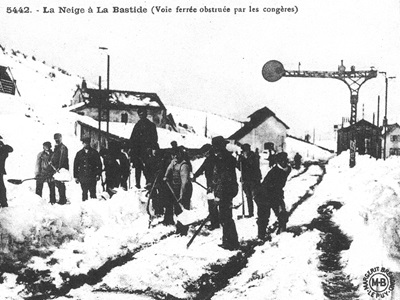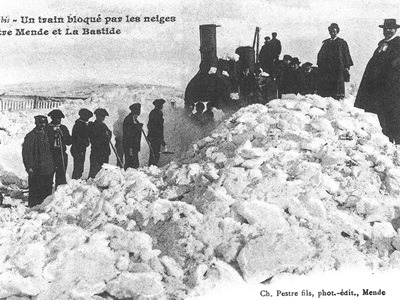

 Fernand, not inclined toward agricultural work and somewhat desperate, had decided in turn to desert this challenging region. He had left silently one January morning this year, just as dawn unravels insomnia. Ill-shod, he made his way to La Bastide-Puylaurent, where the construction of the future railway line, the “Translozérienne,” required a substantial workforce. A grand project of the 19th century, the initial plan for this line connecting Le Puy-en-Velay to Nîmes, serving Grandrieu, Rieutort-de-Randon, Mende, and Florac, encountered various fortunes.
Fernand, not inclined toward agricultural work and somewhat desperate, had decided in turn to desert this challenging region. He had left silently one January morning this year, just as dawn unravels insomnia. Ill-shod, he made his way to La Bastide-Puylaurent, where the construction of the future railway line, the “Translozérienne,” required a substantial workforce. A grand project of the 19th century, the initial plan for this line connecting Le Puy-en-Velay to Nîmes, serving Grandrieu, Rieutort-de-Randon, Mende, and Florac, encountered various fortunes.
Initially presented in 1855 by the prefect of Lozère, it was simply rejected by the study commission under the personal pressure of President Napoleon III. Fortunately, with some modifications, the second program became the definitive project, despite impulsive opposition primarily from the neighboring department of Ardèche. Overcoming these many reservations and with the influence of Mr. Talabot, the future general director of PLM, and Mr. Théophile Roussel, then deputy of Lozère, the plan finally seemed accepted, and on June 19, 1857, the government declared the line to be of public utility.
 Since then, on the ground, the work proved titanic, particularly arduous and dangerous. Already, the objective had been marred by tragedy several times, but against all odds, the construction progressed, albeit slowly, with the understanding that abandonment was not part of the agreed-upon terms. The construction was well and truly underway. Yet, difficulties accumulated, and unforeseen obstacles, hidden by nature, confronted the engineers, risking at any moment to discourage the laboring masses.
Since then, on the ground, the work proved titanic, particularly arduous and dangerous. Already, the objective had been marred by tragedy several times, but against all odds, the construction progressed, albeit slowly, with the understanding that abandonment was not part of the agreed-upon terms. The construction was well and truly underway. Yet, difficulties accumulated, and unforeseen obstacles, hidden by nature, confronted the engineers, risking at any moment to discourage the laboring masses.
The layout and profile of this railway line necessitated the excavation of a large number of tunnels and the construction of gigantic works of art, such as viaducts, some of which seemed to touch the sky from their eighty meters high. Jean-Baptiste had been particularly informed about this by a peddler who came from Langogne to offer clothing accessories. While the merchant was shrewd in business, he was not stingy with information. Taking advantage of the hospitality acquired during a late afternoon and after some trivial matters of little importance, he intelligibly detailed the incredible undertaking and the magnitude of the projects across Lozère. He described the chosen sites as rugged, wild, and devilishly difficult to access, selecting a deep valley, deeply incised, winding at the foot of the “Grattassac,” formed from shredded shale resulting from millennia of erosion, to illustrate his points.
 Jean-Baptiste thoroughly tested the accuracy of the peddler’s comments, and only then did he become genuinely interested in the progress of this endeavor. But if these places remain so steep, how do they plan to cross this mountain? he inquired. I’m getting to that! This summit will ultimately be conquered by a seven-hundred-meter-long tunnel, allowing future trains to pass from the Allier Valley to the Altier Valley, avoiding the high peaks. The merchant lingered more extensively on the passage through the Chassezac Valley, a true marvel for the eyes—a place where surely God created beauty! he added before continuing his technical exposition on the drilling of the Albespeyres Tunnel near Prévenchères.
Jean-Baptiste thoroughly tested the accuracy of the peddler’s comments, and only then did he become genuinely interested in the progress of this endeavor. But if these places remain so steep, how do they plan to cross this mountain? he inquired. I’m getting to that! This summit will ultimately be conquered by a seven-hundred-meter-long tunnel, allowing future trains to pass from the Allier Valley to the Altier Valley, avoiding the high peaks. The merchant lingered more extensively on the passage through the Chassezac Valley, a true marvel for the eyes—a place where surely God created beauty! he added before continuing his technical exposition on the drilling of the Albespeyres Tunnel near Prévenchères.
Jean-Baptiste, do you realize? he emphasized. The future railway line will traverse one thousand five hundred and twenty meters of gallery beneath this extremely stubborn mountain. A colossal undertaking, he declared, in granite of unimaginable strength. When you think about it! he added, in the manner of a distinguished technician. The progress by excavation amounts to a mere twenty centimeters per day. Furthermore! he continued, seemingly inexhaustible on the subject. Due to blatant risks of asphyxiation for the drivers and mechanics present at the construction site, there are plans to build a ventilation plant at the entrance of the tunnel—an innovation in this field.
 Jean-Baptiste was lost in this narrative, surprised by the wealth of knowledge presented. He desperately tried to assimilate these barbaric terms, hitherto unknown in his own vocabulary. However, due to a certain pride, he attempted to conceal his scientific shortcomings. He searched and found an appropriate question. But how many such infrastructures will this line require? Approximately ten tunnels of varying significance between La Bastide-Puylaurent and Concoules, complemented by four or five viaducts, employing over two thousand five hundred workers for the Villefort sector alone. It’s grandiose, extraordinary! exclaimed Jean-Baptiste, feigning enthusiasm.
Jean-Baptiste was lost in this narrative, surprised by the wealth of knowledge presented. He desperately tried to assimilate these barbaric terms, hitherto unknown in his own vocabulary. However, due to a certain pride, he attempted to conceal his scientific shortcomings. He searched and found an appropriate question. But how many such infrastructures will this line require? Approximately ten tunnels of varying significance between La Bastide-Puylaurent and Concoules, complemented by four or five viaducts, employing over two thousand five hundred workers for the Villefort sector alone. It’s grandiose, extraordinary! exclaimed Jean-Baptiste, feigning enthusiasm.
Jean-Baptiste, do you realize? he emphasized. The future railway line will traverse one thousand five hundred and twenty meters of gallery beneath this extremely stubborn mountain. A colossal undertaking, he declared, in granite of unimaginable strength. When you think about it! he added, in the manner of a distinguished technician. The progress by excavation amounts to a mere twenty centimeters per day. Furthermore! he continued, seemingly inexhaustible on the subject. Due to blatant risks of asphyxiation for the drivers and mechanics present at the construction site, there are plans to build a ventilation plant at the entrance of the tunnel—an innovation in this field.
 Jean-Baptiste was lost in this narrative, surprised by the wealth of knowledge presented. He desperately tried to assimilate these barbaric terms, hitherto unknown in his own vocabulary. However, due to a certain pride, he attempted to conceal his scientific shortcomings. He searched and found an appropriate question. But how many such infrastructures will this line require? Approximately ten tunnels of varying significance between La Bastide-Puylaurent and Concoules, complemented by four or five viaducts, employing over two thousand five hundred workers for the Villefort sector alone. It’s grandiose, extraordinary! exclaimed Jean-Baptiste, feigning enthusiasm.
Jean-Baptiste was lost in this narrative, surprised by the wealth of knowledge presented. He desperately tried to assimilate these barbaric terms, hitherto unknown in his own vocabulary. However, due to a certain pride, he attempted to conceal his scientific shortcomings. He searched and found an appropriate question. But how many such infrastructures will this line require? Approximately ten tunnels of varying significance between La Bastide-Puylaurent and Concoules, complemented by four or five viaducts, employing over two thousand five hundred workers for the Villefort sector alone. It’s grandiose, extraordinary! exclaimed Jean-Baptiste, feigning enthusiasm.
But how much will these works cost? A fortune, surely? Indeed! The cost of this enormous project will undoubtedly seem excessive to us. Regardless, the sums invested in this endeavor surpass our comprehension. For instance, approximately eight hundred thousand gold francs for the construction of the viaduct over the Altier, which is twice less expensive than the one built in Chamborigaud. Yet these amounts may appear modest compared to the two million gold francs allocated for the completion of the Albespeyres Tunnel. Well! Jean-Baptiste reacted, stunned by the mention of such sums. (He allowed himself a moment of reflection to recalibrate his understanding of values :) These are truly colossal fortunes! he admitted. It no longer surprises me that our dear deputy, Théophile Roussel, expresses such warm gratitude to President Louis Napoléon.
He casually picked up the newspaper lying on the table. Here! Read it for yourself! Right there! On the front page! Jean-Baptiste insisted, handing the brochure to his interlocutor. I’ve kept this copy meticulously because intercepting a local publication here is as remarkable an achievement as sowing barley on Mont Lozère. The peddler donned thick glasses, perched on his prominently rose-violet-colored nose, and read the article aloud without hesitation. “Letter addressed by Théophile Roussel, deputy of Lozère, to President Louis Napoléon Bonaparte. Excerpt from the ‘Moniteur de la Lozère’: ‘Sire, by ordering the implementation of the law of June 19, 1857, you have deigned to cast your eyes upon this interesting yet often forgotten region. By connecting it to the railway network, you have breathed new life into it. A chronicle of an era. By Serge Durie. Society of Writers.
Old romantic Hotel, L'Etoile Guest-House is a mountain retreat in the South of France. With a beautiful park along the Allier River, L'Etoile Guesthouse is located in La Bastide-Puylaurent between Lozere, Ardeche and Cevennes. Hiking trails: GR®70 Stevenson trail, GR®700 Regordane way (St Gilles trail), GR®7, GR®72, GR®470 Allier river trail. Hiking loops: Cevenol, Ardechoise, Margeride. The right place to relax.
Copyright©gr-infos.com